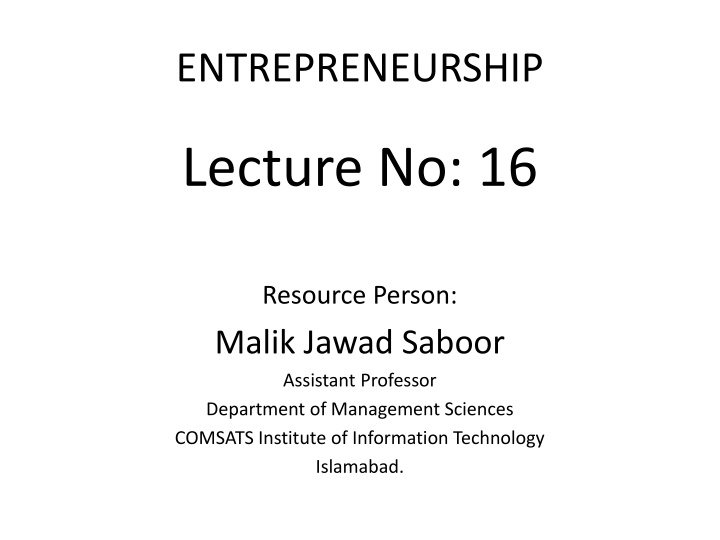
Feasibility Analysis in Entrepreneurship: Strategies and Considerations
Learn about the importance of feasibility analysis in entrepreneurship, including the TOWS Matrix strategies and elements such as product/service, industry, and financial feasibility. Discover how entrepreneurs can assess the viability of their business ideas before committing resources. Dive into various strategies for building competitive advantage and mitigating threats in the market.
Download Presentation

Please find below an Image/Link to download the presentation.
The content on the website is provided AS IS for your information and personal use only. It may not be sold, licensed, or shared on other websites without obtaining consent from the author. If you encounter any issues during the download, it is possible that the publisher has removed the file from their server.
You are allowed to download the files provided on this website for personal or commercial use, subject to the condition that they are used lawfully. All files are the property of their respective owners.
The content on the website is provided AS IS for your information and personal use only. It may not be sold, licensed, or shared on other websites without obtaining consent from the author.
E N D
Presentation Transcript
ENTREPRENEURSHIP Lecture No: 16 Resource Person: Malik Jawad Saboor Assistant Professor Department of Management Sciences COMSATS Institute of Information Technology Islamabad.
TOWS Matrix SO Strategies Strategies that enable competitive advantage, external opportunities match well with internal strengths, allows for competitive advantage to be built and maintained.
TOWS Matrix ST Strategies Mitigation Strategies, firm possesses internal strengths that facilitates neutralization of external threats, may lead to temporary advantage if competitors are impacted by environmental threats.
TOWS Matrix WO Strategies Acquisition/Development Strategies, situation where strategies are formulated to acquire or develop new resources/capabilities to take advantage of external opportunities.
TOWS Matrix WT Strategies Consolidation/Exit Strategies, if firms can t find ways to convert weaknesses to strengths via acquisition/development, exit from market is recommended.
Feasibility Analysis Entrepreneurs do not lack creative ideas, but Is a particular idea a viable foundation for creating a successful business? Feasibility study addresses the question: Should we proceed with this business idea?
Feasibility Study Not the same as a business plan. Serves as a filter, screening out ideas that lack the potential for building a successful business before an entrepreneur commits the necessary resources to building a business plan. An investigative tool.
Elements of a Feasibility Analysis Product or Service Feasibility Industry and Market Feasibility Financial Feasibility
Elements of a Feasibility Analysis Product or Service Feasibility Industry and Market Feasibility Financial Feasibility
Industry and Market Feasibility Analysis Two areas of focus: Determining how attractive an industry is overall as a home for a new business. Identifying possible niches a small business can occupy profitably.
The Five-Forces Model of Competition: A Key Analytical Tool
Factors Affecting the Strength of Rivalry Slow growth in product demand Low switching cost Competitors are numerous and of almost same size Factors Affecting the Threat of Entry Entry ease/barriers Buyers demand is increasing rapidly Large pool of potential entrants Factors Affecting Supplier Power Supplies are in limited supply No substitute available High Switching Costs
Factors Affecting Competition from Substitute Products Good substitutes are readily available Substitutes have better performance features Buyers have low cost of Switching Factors Affecting the Bargaining Power of Buyers Industry Products are standardized Low Switching cost Buyers are well informed about to quality and prices Low number of buyers
Business Prototyping Entrepreneurs test their business models on a small scale before committing serious resources to launch a business that might not work. Recognizes that a business idea is a hypothesis that needs to be tested before taking it full scale.
Elements of a Feasibility Analysis Product or Service Feasibility Industry and Market Feasibility Financial Feasibility
Product or Service Feasibility Analysis Determines the degree to which a product or service idea appeals to potential customers and identifies the resources necessary to produce it. Two questions: Are customers willing to purchase our good or service? Can we provide the product or service to customers at a profit?
Product or Service Feasibility Analysis Primary research collect data firsthand and analyze it. Customer surveys and questionnaires Focus groups Secondary research gather data that already has been compiled and analyze it. Prototypes In-home trials
Elements of a Feasibility Analysis Product or Service Feasibility Industry and Market Feasibility Financial Feasibility
Financial Feasibility Analysis Capital requirements must have an estimate of how much start-up capital is required to launch the business. Estimated earnings forecasted income statements. Return on investment combining the previous two estimates to determine how much investors can expect their investments to return.






















